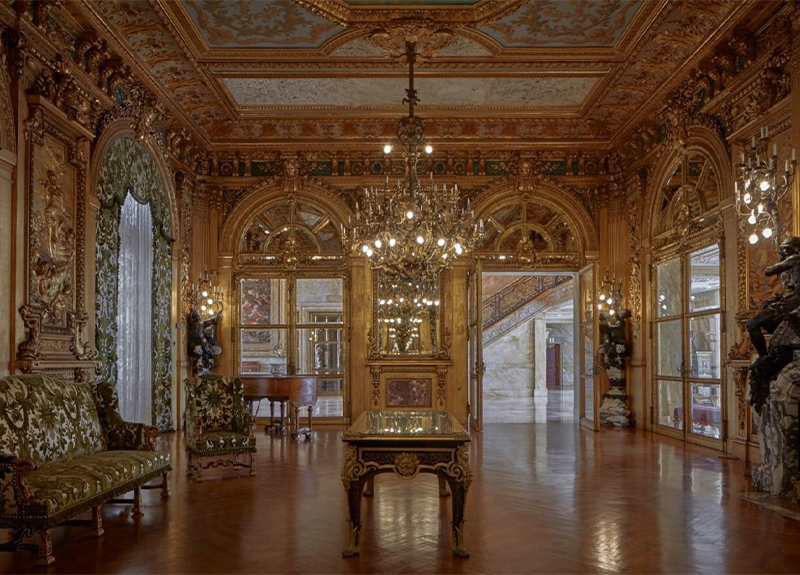-and-
Richard Morris Hunt was perhaps the most influential American architect of the late 19th century. He went to Paris to study, then returned to spread the Beaux-Arts gospel and give America architecture that matched its ambitions. He designed castles that defined the Gilded Age, such as Breakers and Marble House in Rhode Island, and the Biltmore in North Carolina.
Source: Library of Congress (Photos: Courtesy)
—This is a guest post by Susan Reyburn, a writer-editor in the Publishing Office. It also appears in the September-October issue of the Library of Congress Magazine.
Who was Richard Morris Hunt, and why was he so famous? Why was he forgotten, even as images of his creations continued to illuminate hefty coffee table books and characters on HBO’s “The Gilded Age” referred to him by name?
For impossibly wealthy industrialists, Hunt was the architect of choice in building, furnishing and decorating mansions that combined Old World aesthetics with American ingenuity and spirit. For millions of poor European immigrants, his work was among the first things they saw on approaching New York Harbor, with the Statue of Liberty standing atop the monumental pedestal he designed.

Some of those new arrivals, as domestic servants, would become very familiar with Hunt’s floorplans as they hurried up and down hidden back stairs. Others might eventually have lived in one of his apartment buildings or his retirement home for “respectable aged and indigent females.”
“When viewed as a cultural leader, Hunt emerges as astonishingly relevant to the critical assessment of America’s ‘master narrative,’ ” writes historian Sam Watters in his new book, “The Gilded Life of Richard Morris Hunt: Architecture & Art for an American Civilization,” just published by Giles Ltd. in association with the Library. “Tourists may not know his name, but they experience the buildings and art that he and his colleagues and patrons conceived and collected to build an American civilization. Their museums, libraries, and mansions extended what President Lincoln, on the verge of the Civil War, called ‘our national fabric, with all its benefits, its memories, and its hopes.’ ”
A native of Brattleboro, Vermont, and the son of a U.S. congressman, Hunt was born in 1827. He descended from Revolutionary War patriots and ascended to the highest ranks of his profession. His widowed mother, Jane M. Leavitt Hunt, ferried her five children to Europe in 1843, calling the endeavor “venturesome in the extreme,” and an opportunity for advanced schooling that was not yet available in the United States, especially in the arts.

The young Hunt became the first American to study architecture at the École des Beaux-Arts in Paris, becoming a construction inspector at the Louvre and taking extensive sketching trips through Europe and the Middle East.
-and-
With Yankee bona fides and European training, he returned to the United States in 1855, then in his late twenties, determined to spread the Beaux-Arts gospel and give America architecture that matched its ambitions. But Hunt also was practical, tending to the wishes of his often-demanding clientele and telling his son, “If they want you to build a house upside down standing on a chimney, it’s up to you to do it.”
None other than Ralph Waldo Emerson cited Hunt and his brothers William, a leading painter, and legal scholar Leavitt as representing a remarkable American family. The sage of Concord might have been further impressed had he met the other siblings — Jonathan, a physician dedicated to working with the poor, and Jane, also an accomplished artist.

He regarded Richard as a “thinking soul … horsed on a robust & vivacious temperament” who “expressed with the vigor & fury … fine theories of the possibilities of art.” Emerson soon added Richard to his short list of men who were making major contributions to the young nation’s progress, among them naturalist John Muir and transcendentalist Henry David Thoreau.
The best-known surviving works on Hunt’s lengthy resume include the Fifth Avenue main entrance to the Metropolitan Museum of Art in New York, the Breakers and Marble House mansions in Newport, Rhode Island, and Biltmore, in Asheville, North Carolina. In addition to his residential castles for Vanderbilts and Astors, his range was extraordinary, from early apartment buildings and skyscrapers to modern hospitals, university facilities and churches.
But Hunt built more than buildings: He was essential in developing the nascent American architectural field as a profession, with established standards, business practices and training curricula. As a plaintiff in an 1861 lawsuit, Hunt successfully argued that clients pay professional architects fees for their creative and conceptional work, elevating the role of the architect above that of traditional builders and construction supervisors.
His technical innovations included the use of lightweight terracotta hollow block floor construction and enclosed iron vertical supports to improve fireproofing. Hunt’s office also mastered the art of magnificent presentation drawings, encouraging clients to see what was possible in the hands of a cultured architect.
As well-travelled, well-educated, self-appointed arbiters of good taste, Hunt and his circle took it upon themselves to instruct the public in what was beautiful and important.
He co-founded the Metropolitan Museum of Art, the American Institute of Architects — he later served as its president — and the Municipal Art Society. Unusual among architects, Hunt encouraged his clients to acquire and later bequeath art collections to institutions for safekeeping and exhibition, making them accessible to the public.

His contemporaries regarded him as the dean of American architecture; even with some critical failures and lost commissions, his was a stellar 40-year career, bolstered by his gift for self-promotion and mentoring successful young successors. Not long after he was memorialized in granite and bronze off Fifth Avenue in Central Park, Hunt’s work was overtaken by modernism. He disappeared from the national conversation on art and culture that he had so fervently helped to create.
It was Hunt’s robust interdisciplinary range that first intrigued Watters.
Ford Peatross, the founding director of the Center for Architecture, Design, and Engineering at the Library, tipped him off to the richness of the Richard Morris Hunt Collection when it was acquired in 2010.
Peatross suggested Watters might write about and catalog the material as he had done with the collection of pioneering photographer Frances Benjamin Johnston. Watters was further drawn to “Hunt’s astounding range of art-related activities — architect, collector, educator — in diverse social settings, all to the end of building a ‘civilized’ America,” and he plunged into the deep end of Huntiana. Fortunately, Mari Nakahara, Peatross’ eventual successor, was already there.
Nakahara knew the Hunt holdings well, having worked with the material when it was housed at the Octagon, the museum of the American Architectural Foundation, in Washington, D.C., before the collection came to the Library.

Watters and Nakahara worked their way through Hunt’s well-preserved archive of more than 10,000 items, including an unpublished biography by his wife, Catharine Howland Hunt; numerous sketchbooks; architectural drawings from his student days to his decades as head of his own firm; notable photography from the United States and abroad; scrapbooks that he and Catharine assembled filled with reference images; and his library of architecture books, with some French and Italian tomes dating to the 17th century.
“People may not know that the Library collects architectural materials,” says Nakahara, who is especially partial to Hunt’s 1847 iron bridge drawing from his days at the École. “The Prints and Photographs Division holds over 4 million items in about 140 collections related to architecture, design and engineering. The easiest way to study and enjoy our collection is via our research guide. In this digital era, though, people believe everything is available online, but that is not true. I strongly recommend that people see the originals.”





